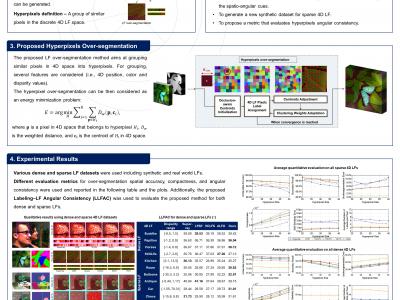Documents
Poster
HYPERPIXELS: FLEXIBLE 4D OVER-SEGMENTATION FOR DENSE AND SPARSE LIGHT FIELDS

- DOI:
- 10.60864/fzyz-h513
- Citation Author(s):
- Submitted by:
- Maryam Hamad
- Last updated:
- 4 April 2024 - 6:54am
- Document Type:
- Poster
- Document Year:
- 2024
- Presenters:
- Maryam Hamad
- Paper Code:
- IVMSP-P21.12: Segmentation
- Categories:
- Log in to post comments
4D Light Field (LF) imaging, since it conveys both spatial and angular scene information, can facilitate computer vision tasks and generate immersive experiences for end-users.
A key challenge in 4D LF imaging is to flexibly and adaptively represent the included spatio-angular information to facilitate subsequent computer vision applications. Recently, image over-segmentation into homogenous regions with perceptually meaningful information has been exploited to represent 4D LFs. However, existing methods assume densely sampled LFs and
do not adequately deal with sparse LFs with large occlusions. Furthermore, the spatio-angular LF cues are not fully exploited in the existing methods. In this paper, the concept of hyperpixels is defined and a flexible, automatic, and adaptive representation for both dense and sparse 4D LFs is proposed. Initially, disparity
maps are estimated for all views to enhance over-segmentation accuracy and consistency. Afterwards, a modified weighted K-means clustering using robust spatio-angular features is performed in 4D Euclidean space. Experimental results on several dense and sparse 4D LF datasets show competitive and outperforming performance in terms of over-segmentation accuracy, shape regularity and view consistency against state-of-the-art methods.

